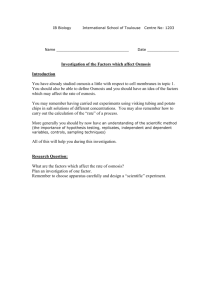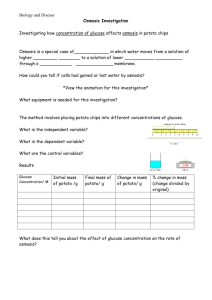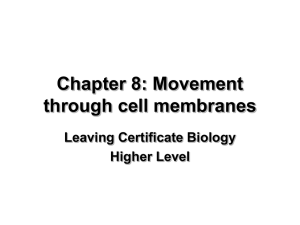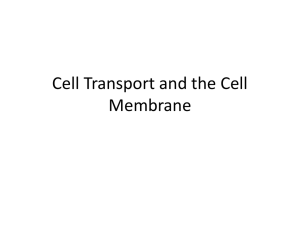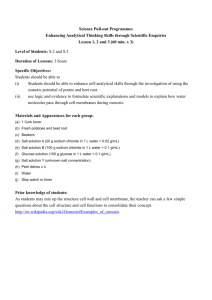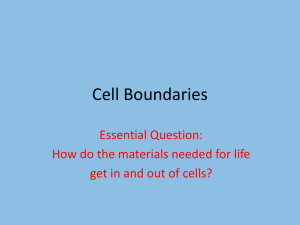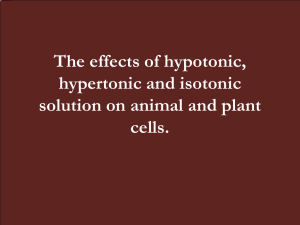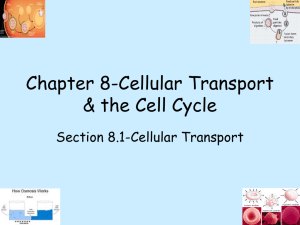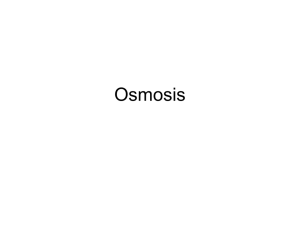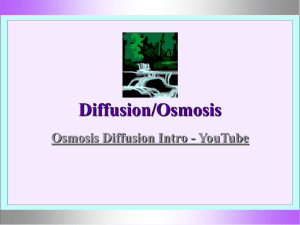Unit 1: Topic 2 Practical`s
advertisement
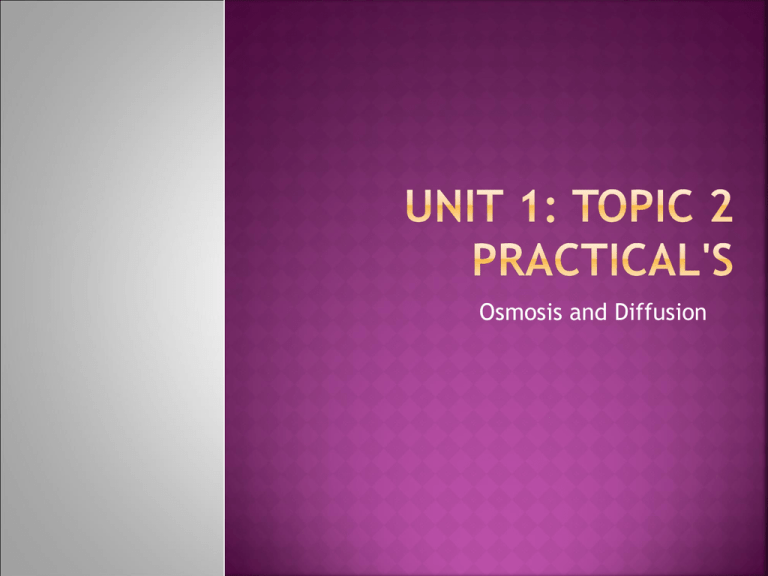
Osmosis and Diffusion Practical 1 Learning objectives: By the end of the lesson you should be able to: Explain the movement of water in plant and animal cells by the process of osmosis. Describe the effect of osmosis on plant and animal cells. Osmosis is the diffusion of water Across a selectively permeable membrane ___________________ Visking tubing is an artificial membrane which acts ____________ like a cell membrane Model cell A ___________ can be made by making a bag out of the visking tubing and filling it with the appropriate solutions To demonstrate Osmosis Method 1. 2. 3. Your teacher will show you how to set up the model cell shown in the diagram Dry and weigh the model cell, then place it in a beaker and cover with distilled water. After 24 hours dry and reweigh the model cell 10% sucrose solution Visking Tubing Results Time Start After 24 Hours Mass (g) What happens to the model cell and what causes this change? The mass increases due to the movement of water by osmosis What precautions are taken in this experiment? Making sure that the model cell is dried properly so that no water is on the outside of the bag to affect the mass readings Practical 2 Learning objectives: By the end of the lesson you should be able to: Describe the effect of placing cells in a HYPERTONIC solution. Describe the effect of placing cells in an ISOTONIC solution. Describe the effect of placing cells in a HYPOTONIC solution. Diffusion of water across a selectively is the________________________________ permeable membrane _________________ When plant cells are placed in hypertonic solutions Osmosis plasmolysis then ________ will take place and ________ ____ can be seen Osmosis To observe osmosis in cells 1. 2. 3. Label 2 slides A and B Make 2 wet slides of the specimen adding distilled water to A and 10% sucrose solution to B After a few minutes observe and draw the appearance of one cell from slide A and one from slide B Slide A Distilled Water Slide B – 10% sucrose Solution What happens to the cell in 10% sucrose solution? The membrane pulls away from the wall Why does this happen? Water moves out of the vacuole by osmosis causing the contents to shrink What is the name given to this condition? Plasmolysis Why To are the cells left for a few minutes? allow sufficient time for the process to occur Practical 3 Learning objectives: By the end of the lesson you should be able to: Describe the effect of placing cells in a HYPERTONIC solution. Describe the effect of placing cells in an ISOTONIC solution. Describe the effect of placing cells in a HYPOTONIC solution. When placed in solutions which have a different concentration to its cells, plant tissue will show change in mass due to osmosis taking place a _____________________________________ Isotonic an ___________ solution plant tissue will neither gain or loose mass. Hypotonic In a _____________ solution plant tissue will gain mass. Hypertonic In a ______________ solution plant tissue will lose mass In To measure the concentration of cell sap in potato tissue 1. 2. 3. 4. 5. Add 20cm of each sucrose solution to 5 labelled boiling tubes using a syringe Cut 5 thin cores of potato tissue with a cork borer on a cutting tile and cut them to 2cm in length with a knife. Dry the pieces of tissue then weigh them and record the initial masses in your results table. Add one core to each tube and leave for 25 minutes at room temperature Remove the tissue from the solutions, dry, reweigh and record the final masses in your results table. Concentration of solution (M) 0.1 0.2 0.3 0.4 0.5 Initial Mass (g) Final Mass (g) Calculate the change in mass by subtracting the initial mass from the final mass. Some of the changes are positive, The core has gained mass. Some of the changes are negative, the core has lost mass Calculate the percentage change in mass by dividing the change in mass by the initial mass and multiplying the answer by 100. Concentration of solution (M) 0.1 0.2 0.3 0.4 0.5 Change in mass (g) Percentage change in mass (g) Draw a line graph of these results + % Change in mass 0 0.1 0.2 0.3 0.4 0.5 Concentration of solution (M) The potato tissue and its surrounding solution are the same strength when there is no change in mass. This is identified on the plotted line at 0% change in mass What is the concentration of the cell sap in the potato tissue? Evaluation How could pooling the class results or repeating the experiment improve the reliability of the results? It would reduce the effect of an unusual result
